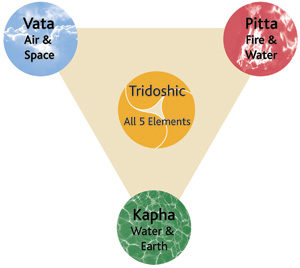Basic Principles of Ayurveda
 While Ayurvedic principles can be used to explain the complexity of not only health, but also the world around us, there are several simple basics that become the building blocks for everything else:
While Ayurvedic principles can be used to explain the complexity of not only health, but also the world around us, there are several simple basics that become the building blocks for everything else:
- Ayurveda’s fundamental approach to well-being is that you must reach your unique state of balance in your whole being—body, mind, and spirit.
- Ayurveda views the world in light of 3 constitutional principles: vata, pitta, and kapha. These are explained in more detail below.
- The first line of defense in combating imbalances is to remove the cause of the problem. If the trouble-maker is out of the picture, the body starts being able to heal itself. For example, if pollutants are bothering your nasal passages and sinuses, rinse them out with a traditional Ayurvedic remedy, the neti pot.
- If there are any lingering imbalances after removing the inciting cause, then bring balance by using opposites. For example, the Ayurvedic remedy to excess heat is to use something cooling. So for excess heat or acidity in the digestive system, you could use cooling and soothing herbs like Shatavari.
- Always support the digestive fire, so that nutrition can be absorbed and waste materials can be eliminated. Vata, Pitta, and Kapha: Your Viewing Lenses
- Once you put on the lens of Ayurveda and see things in terms of vata, pitta, kapha, and combinations thereof, the whole world comes alive in a new way. Look at the world around you! The doshas take form in endlessly interesting ways.
Vata
Pitta
Pitta brings forth the qualities of fire and water. It is sharp, penetrating, hot, light, liquid, mobile, and oily. Pitta’s domain is the principal of transformation. Just as fire transforms anything it touches, pitta is in play any time the body converts or processes something. So pitta oversees digestion, metabolism, temperature maintenance, sensory perception, and comprehension. Imbalanced pitta can lead to sharpness and inflammation in these areas in particular.
Kapha
Kapha, composed of earth and water, is heavy, cold, dull, oily, smooth, dense, soft, static, liquid, cloudy, hard, and gross (in the sense of dense or thick). As kapha governs stability and structure, it forms the substance of the human body, from the skeleton to various organs to the fatty molecules (lipids) that support the body. An excess of kapha leads to an overabundance of density, heaviness, and excess in the body.
